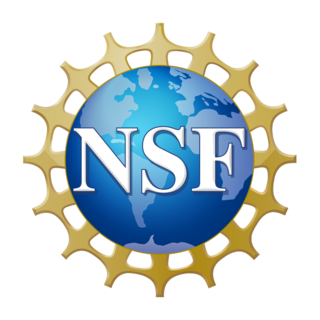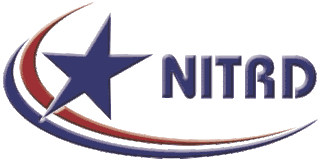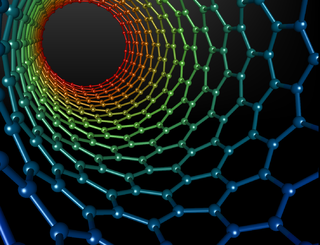Related Research Articles

Nanotechnology was defined by the National Nanotechnology Initiative as the manipulation of matter with at least one dimension sized from 1 to 100 nanometers (nm). At this scale, commonly known as the nanoscale, surface area and quantum mechanical effects become important in describing properties of matter. The definition of nanotechnology is inclusive of all types of research and technologies that deal with these special properties. It is therefore common to see the plural form "nanotechnologies" as well as "nanoscale technologies" to refer to the broad range of research and applications whose common trait is size. An earlier description of nanotechnology referred to the particular technological goal of precisely manipulating atoms and molecules for fabrication of macroscale products, also now referred to as molecular nanotechnology.

The U.S. National Science Foundation (NSF) is an independent agency of the United States federal government that supports fundamental research and education in all the non-medical fields of science and engineering. Its medical counterpart is the National Institutes of Health. With an annual budget of about $9.9 billion, the NSF funds approximately 25% of all federally supported basic research conducted by the United States' colleges and universities. In some fields, such as mathematics, computer science, economics, and the social sciences, the NSF is the major source of federal backing.

The Center for Nanoscale Materials is one of five Nanoscale Science Research Centers the United States Department of Energy sponsors. The Center is at Argonne National Laboratory location in Lemont, Illinois.
Nanomanufacturing is both the production of nanoscaled materials, which can be powders or fluids, and the manufacturing of parts "bottom up" from nanoscaled materials or "top down" in smallest steps for high precision, used in several technologies such as laser ablation, etching and others. Nanomanufacturing differs from molecular manufacturing, which is the manufacture of complex, nanoscale structures by means of nonbiological mechanosynthesis.
The history of nanotechnology traces the development of the concepts and experimental work falling under the broad category of nanotechnology. Although nanotechnology is a relatively recent development in scientific research, the development of its central concepts happened over a longer period of time. The emergence of nanotechnology in the 1980s was caused by the convergence of experimental advances such as the invention of the scanning tunneling microscope in 1981 and the discovery of fullerenes in 1985, with the elucidation and popularization of a conceptual framework for the goals of nanotechnology beginning with the 1986 publication of the book Engines of Creation. The field was subject to growing public awareness and controversy in the early 2000s, with prominent debates about both its potential implications as well as the feasibility of the applications envisioned by advocates of molecular nanotechnology, and with governments moving to promote and fund research into nanotechnology. The early 2000s also saw the beginnings of commercial applications of nanotechnology, although these were limited to bulk applications of nanomaterials rather than the transformative applications envisioned by the field.
The impact of nanotechnology extends from its medical, ethical, mental, legal and environmental applications, to fields such as engineering, biology, chemistry, computing, materials science, and communications.
The following outline is provided as an overview of and topical guide to nanotechnology:
In 2007, productive nanosystems were defined as functional nanoscale systems that make atomically-specified structures and devices under programmatic control, i.e., performing atomically precise manufacturing. As of 2015, such devices were only hypothetical, and productive nanosystems represented a more advanced approach among several to perform Atomically Precise Manufacturing. A workshop on Integrated Nanosystems for Atomically Precise Manufacturing was held by the Department of Energy in 2015.
Green nanotechnology refers to the use of nanotechnology to enhance the environmental sustainability of processes producing negative externalities. It also refers to the use of the products of nanotechnology to enhance sustainability. It includes making green nano-products and using nano-products in support of sustainability.

Mihail C. Roco is the founding chair of the US National Science and Technology Council subcommittee on Nanoscale Science, Engineering and Technology (NSET), and is Senior Advisor for Science and Engineering, including Nanotechnology, at the National Science Foundation. He is also the editor in chief of the Journal of Nanoparticle Research.

The California NanoSystems Institute (CNSI) is an integrated research center operating jointly at UCLA and UC Santa Barbara. Its missions are to foster interdisciplinary collaborations for discoveries in nanosystems and nanotechnology; train the next generation of scientists, educators and technology leaders; and facilitate partnerships with industry, fueling economic development and the social well-being of California, the United States and the world.
Discovery Park is a 40-acre (160,000 m2) multidisciplinary research park located in Purdue University's West Lafayette campus in the U.S. state of Indiana. Tomás Díaz de la Rubia, an energy and resources industry executive who also spent a decade as a top scientist and administrator at Lawrence Livermore National Laboratory, serves as Discovery Park's Vice President.
The College of Nanotechnology, Science, and Engineering is part of the University at Albany, SUNY in Albany, New York. Founded in 2004 at the University at Albany, SUNY, the college underwent rapid expansion in the late-2000s and early-2010s before merging with the SUNY Institute of Technology in 2014. The college rejoined the University at Albany in 2023. The college was the first college in the United States devoted to nanotechnology.
Indian Institute of Nano Science & Technology (IINSc) is a research institution that teaches nano science and technology. It is located in Bangalore, India.

The Networking and Information Technology Research and Development (NITRD) program consists of a group of U.S. federal agencies to research and develop information technology (IT) capabilities to empower Federal missions; support U.S. science, engineering, and technology leadership; and bolster U.S. economic competitiveness.
The International Institute for Nanotechnology (IIN) was established by Northwestern University in 2000. It was the first institute of its kind in the United States and is one of the premier nanoscience research centers in the world. Today, the IIN represents and unites more than $1 billion in nanotechnology research, educational programs, and supporting infrastructure.

Nanotechnology in warfare is a branch of nano-science in which molecular systems are designed, produced and created to fit a nano-scale (1-100 nm). The application of such technology, specifically in the area of warfare and defence, has paved the way for future research in the context of weaponisation. Nanotechnology unites a variety of scientific fields including material science, chemistry, physics, biology and engineering.
Convergence research aims to solve complex problems employing transdisciplinarity. While academic disciplines are useful for identifying and conveying coherent bodies of knowledge, some problems require collaboration among disciplines, including both enhanced understanding of scientific phenomena as well as resolving social issues. The two defining characteristics of convergence research include: 1) the nature of the problem, and 2) the collaboration among disciplines.
References
- ↑ "National Nanotechnology Initiative (NNI): Supplement to the President's FY 2015 Budget" (PDF). Office of Science and Technology Policy. March 2014. Retrieved 28 March 2014.
- ↑ Dr. Mihail C. Roco: Senior Advisor for Nanotechnology, National Science Foundation Archived 11 April 2010 at the Wayback Machine at NSF Directorate of Engineering website
- ↑ M.C. Roco, R.S. Williams, and P. Alivisatos. Nanotechnology Research Directions: Vision for Nanotechnology R&D in the Next Decade. National Science and Technology Council, White House 1999, reprinted Springer 2000, http://www.nano.gov/sites/default/files/pub_resource/research_directions_1999.pdf
- ↑ Roco, Mihail C. (1 February 2011). "The long view of nanotechnology development: the National Nanotechnology Initiative at 10 years". Journal of Nanoparticle Research. 13 (2): 427–445. doi:10.1007/s11051-010-0192-z. ISSN 1572-896X.
- ↑ M.C. Roco, C.A. Mirkin, and M.C. Hersam. Nanotechnology Research Directions for Societal Needs in 2020: Retrospective and Outlook, Springer 2011, https://www.nano.gov/node/948
- ↑ M.C. Roco, W.S. Bainbridge, B. Tonn, and G. Whitesides. Convergence of Knowledge, Technology, and Society: Beyond Convergence of NANO-BIO-INFO-COGNITIVE Technologies, Springer, 2013, http://www.wtec.org/NBIC2-Report/
- 1 2 Roco, Mihail C. (18 September 2023). "National Nanotechnology Initiative at 20 years: enabling new horizons". Journal of Nanoparticle Research. 25 (10): 197. doi:10.1007/s11051-023-05829-9. ISSN 1572-896X.
- ↑ "Nanotechnology Timeline | nano.gov". www.nano.gov. Retrieved 5 December 2020.
- ↑ NNI Supplement to the President's Budget for Fiscal Year 2015
- ↑ "NNI Retrospective Video: Creating a National Initiative (Trailer 3 min.)". www.tvworldwide.net. Retrieved 14 February 2024.
- ↑ "NNI Vision, Goals, and PCAs | nano.gov". www.nano.gov. Retrieved 5 December 2020.
- 1 2 3 "Nanotechnology Signature Initiatives (NSIs) | nano.gov". www.nano.gov. Retrieved 5 December 2020.
- ↑ "Nanotechnology-Inspired Grand Challenges | nano.gov". www.nano.gov. Retrieved 5 December 2020.
- 1 2 Twenty years of US nanopatenting: Maintenance renewal scoring as an indicator of patent value. 2023. World Pat Inf. 73/13. A.L. Porter, M. Markley, R. Snead, N.C. Newman. doi: 10.1016/j.wpi.2023.102178